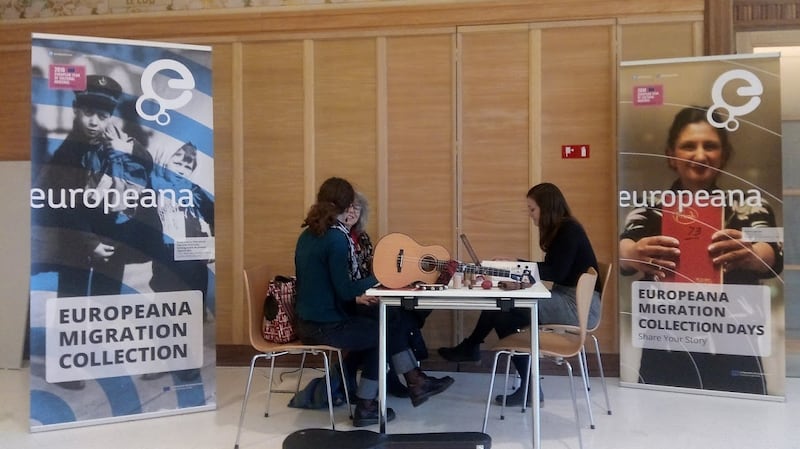Emigrating often means shedding the past so we can embrace the future. But sometimes it’s as much about what we hold onto as what we let go.
The few keepsakes we take with us usually reflect the part of ourselves we wish to cherish, preserve or pass on. For some of us, these objects are treasured family mementos, for others, souvenirs we’ve acquired that remind us of our time overseas or our homelands. Our world is shaped by migration, as generation after generation have travelled across the globe, carrying their ideas - and their objects - with them.
Each of us has a story to tell. We're more mobile than ever. Some of us leave Ireland only to return a little later, and hopefully, a little wiser. Others might never return, but their curious descendants might make their way back to the ancestral sod to forge a deeper connection with their past. Others will travel from across the world to make Ireland their home and enrich our shared cultural heritage.
2018 marks the European Year of Cultural Heritage, and at Epic - the Irish Emigration Museum we’ve already begun to gather the stories of those who have migrated around the world. In May, we held our first emigrant story collecting weekend, and had the pleasure of recording a diverse collection of stories and experiences.

Heirlooms
For some who took part, their most important possessions weren’t those they had acquired themselves, rather the heirlooms they’d inherited and which helped them reflect on their family lineage and the role migration played in shaping their own identities. One Argentinean participant brought along a copy of his Irish great grandfather’s birth certificate: “It is a treasured possession, because our family name is the most important thing to me,” he told us.
The power of these familial ties can even make the world feel like a smaller place. An Australian woman who arrived in Ireland in 2008 felt her ancestral ties made Ireland a more inviting place to live:
"I have a cherished family photo of my Irish ancestors who emigrated to Australia in the 19th century. It is so important to me because when I arrived in Ireland I immediately felt at home."
These objects can also connect us with history. A photograph a participant of Russian origin, living in Ireland since 2001, chose to share of his great grandfather has had pride of place over the mantelpiece in every home he’s ever lived in:

"The photograph was taken before World War II, probably in the 1930s, and shows Anatoly Nekrasov with his young family. It is the only photograph we have of him. He was drafted into the Soviet army and died in the battle of Kursk, the Second World War's largest tank battle. My grandmother was a very young child when he died. Her mother died soon after from grief; her husband and three brothers had all been killed in battle, so my grandmother was raised by her 14 year old brother. They were from the Mari region - the Germans never reached this region, but all the men were drafted into the army to fight.
"The photo and story has gone from Russia, to Lebanon, to Ireland. The photograph is cherished by my family. It reminds each generation where they came from and the sacrifices that were made for their safety. It still moves my grandmother to tears when she visits us and sees it on display."
Insights
Objects can represent powerful transnational bonds between both people and place. They can also link us to lands we've never seen. One Irish contributor inherited a crystal vase that had been a wedding gift his grandparents received in 1926. They took it with them when they left for Canada, and after they passed away it ended up with an aunt in San Francisco. It made its way back to Ireland as a wedding gift once more when our contributor married in 2007, 81 years later.
Other participants highlighted the challenges of building a new life overseas. One Irish man brought along a comic book that helped him deal with the loneliness he felt after arriving in the US:
“Now I’d be lying if I said the trip was everything I dreamed it would be. I loved the city but I quickly became homesick. I may not have lasted a month if I hadn’t discovering the bustling comic book scene of the city. I passed lonely nights by reading fantastic stories and spent all my spare change on any old-looking comic I could find.”

The universality of the emigrant experience - both the highs and the lows - was shared by all those who spoke with us. The diversity of objects they brought provided unique insights into their lives and we’re glad to have had the opportunity to record these important insights into the migrant experience.
The Irish are a nation of emigrants - it has often been said our success has been based on the warm welcome we have received across the globe. Now, we have the opportunity to make people from other lands feel welcome in our country, and to collect the stories that will become part of Irish history in years to come.
In our next collecting weekend, we will be gathering stories from members of new Irish communities who have moved to Ireland from other countries. The stories will then become part of the online Europeana Migration Collection, Europe's digital library, museum, gallery and archive. If you've got a story and object you'd like to share please join us this weekend at Epic The Irish Emigration Museum in Dublin's Docklands: epicchq.com/epic-invites-new-irish-communities-storytelling-collection-weekend
Nathan Mannion is museum curator at Epic.










